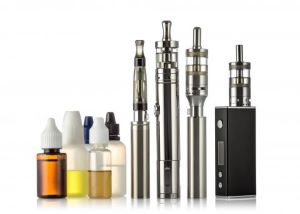
Electronic nicotine delivery systems, such as e-cigarettes, vape pens, mods, and e-cigars, have been steadily gaining popularity among teens. Electronic nicotine delivery systems contain a battery and a heating element and are often designed to look like traditional cigarettes or household items such as flash drives, pens, and lipstick. E-cigarette companies have been successfully advertising to preteens and adolescents by using flavors and designs that appeal to children. 16.1% of high school students in Arizona report using e-cigarettes and, shockingly, 1 in 2 high schoolers in Arizona have tried e-cigarettes.
E-cigarettes heat liquid nicotine to produce an aerosolized mixture of nicotine and flavoring that is inhaled by the user. Vaping is not a safe alternative to smoking. The nicotine in the aerosol is the same addictive chemical found in traditional cigarettes. Adolescent brains are more vulnerable to nicotine addiction and the younger kids are when they start, the more likely they are to develop a lifelong addiction. Toxic compounds, such as formaldehyde, heavy metals, flavoring such as diacetyl, and cancer-causing chemicals are also present in the aerosol of e-cigarettes and can harm developing lungs.
The health consequences of e-cigarettes
- The nicotine in e-cigarettes is highly addictive and harmful to the adolescent brain. E-cigarette liquid is largely unregulated and can contain variable amounts of nicotine. One Juul cartridge contains the same amount of nicotine as a pack of cigarettes. Addiction can occur quickly, even within days to weeks of intermittent e-cigarette use.
- E-cigarette aerosol contains harmful and carcinogenic chemicals that can damage the heart and lungs. E-liquid often contains polyethylene glycol and glycerin which can irritate the lungs. Toxic flavoring chemicals like diacetyl have been linked to serious lung disease. Lead, tin, nickel, copper, and chromium have all been found in e-cigarette aerosol. E-cigarette aerosol also contains very small particles that can deposit deep within the lungs.
- The batteries in e-cigarettes can cause fire and burns. Defective batteries have also been known to explode, causing serious injuries.
- E-cigarette liquid can be poisonous and even fatal if absorbed through the skin or ingested. Symptoms of poisoning include tremors (shakiness), vomiting, drooling, sweating and high heart rate.
- Teens who use e-cigarettes are three times more likely to use conventional tobacco products such as cigarettes.
- Teens who use e-cigarettes are at a higher risk for developing COVID-19 infection.

How can I help my teen quit e-cigarettes?
- Make a pledge to keep your home and car e-cigarette free. If you use e-cigarettes, make sure you keep them out of reach of your children. Do not use these devices around your children or where they spend time. The toxins and nicotine in the aerosol that is exhaled is not safe and can cause harm when inhaled by children or absorbed through their skin.
- Learn to recognize e-cigarettes. Many of the electronic nicotine delivery systems on the market are designed to hide in plain sight. Learn about what’s popular so you can keep an eye out for them.
- Talk to your child about the dangers of vaping. Many teens do not know what is in the e-cigarette liquid they are inhaling. Children and teens are attracted to the flavors and packaging used to sell e-cigarettes and most believe they are less harmful than cigarettes. Let them know that there is no safe level of nicotine and that the toxins they are inhaling can damage their lungs.
- Talk to your pediatrician. Nicotine is very addictive but there are effective methods for quitting. Your pediatrician can share resources that can help kids quit tobacco for good.
